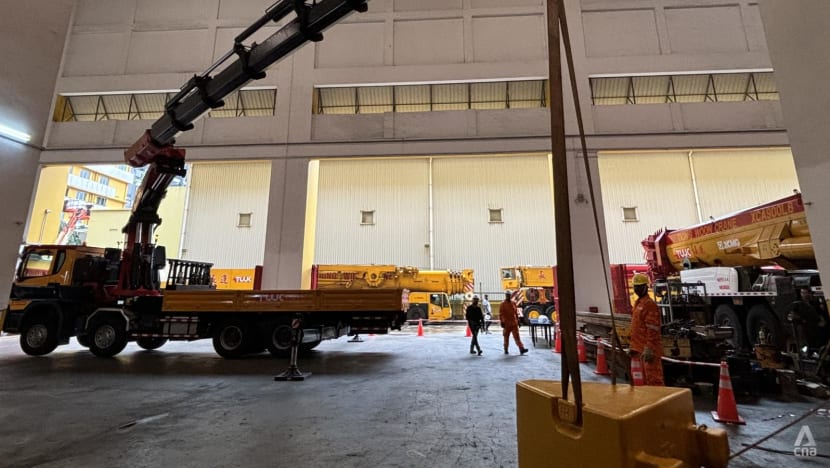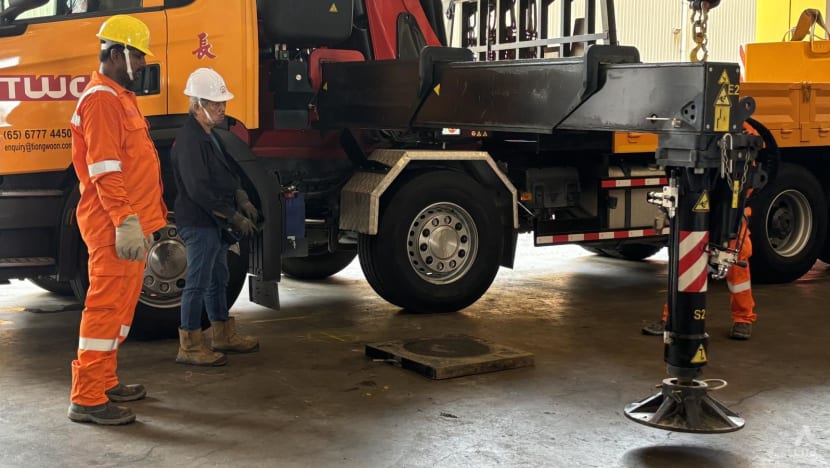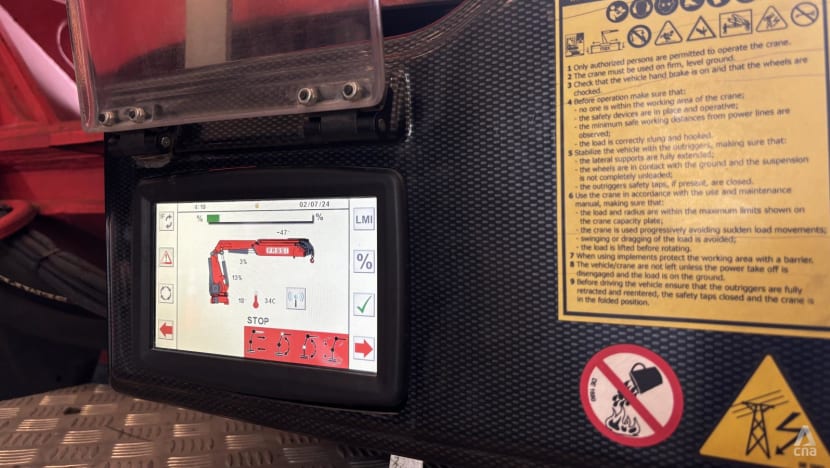New lorry cranes must have stability system from 2025 to eliminate toppling risk
Over the past decade, 63 per cent of all dangerous occurrences involving lorry cranes could have been prevented with a stability control system.

Workers at Tiong Woon Logistics demonstrate how the stability control system on a lorry crane works on Jul 2, 2024. (Photo: CNA/Davina Tham)

This audio is generated by an AI tool.
SINGAPORE: Newly registered lorry cranes must be installed with a stability control system from 2025, to eliminate the risk of the heavy vehicles toppling over.
Over the past decade, 63 per cent of all dangerous occurrences involving lorry cranes could have been prevented with a stability control system, the Ministry of Manpower (MOM) said on Wednesday (Jul 3).
There were a total of 14 dangerous occurrences involving lorry cranes between 2020 and 2024, resulting in two deaths.
Lorry cranes are used to load and unload material and equipment, and are frequently used near public areas, said MOM.
"If the crane topples, it can have a severe impact on workers and it can potentially even impact and affect members of the public," Manpower Minister Tan See Leng said on Wednesday.
Referring to an incident in May when a lorry crane toppled on its side and injured a worker while lifting a concrete bucket, Dr Tan said this would likely have been prevented if a stability control system had been installed.

Lorry cranes have stabilisers in the form of outriggers that extend from the vehicle chassis.
But in some environments where space is constrained, the stabilisers cannot extend fully. This can compromise the safety of lifting operations, said MOM.
A stability control system detects the deployment and extension of each stabiliser, and also takes into account the load being carried by the lorry crane.
The system then calculates and restricts crane manoeuvres within a safe lifting zone.
During a media preview at Tiong Woon Logistics on Tuesday, a lorry crane fitted with the stability control system sounded a loud alarm and flashed an orange light when the crane reached the limit of the safe lifting zone.

Mr Henry Ong, Tiong Woon's deputy manager of operations, said the new requirement would reduce downtime and increase productivity by helping to prevent accidents caused by instability.
"We anticipate a smoother workflow as our equipment will be more reliable and less prone (to) tipping over or losing balance," he told reporters.
There were some challenges, including the initial investment cost, time needed to install the system across the fleet, and ensuring all lorry crane operators were trained to operate the system.
Mr Ong said the cost of installing the stability control system ranged from S$10,000 (US$7,400) to S$12,500, varying according to the specific model and features.
But he added that the long-term benefits in enhanced safety and reduced operational risks outweighed the challenges.
Tiong Woon's lorry crane operators will receive comprehensive training as well as regular refresher courses and assessments to ensure proficiency with the stability control system.
One of them was Mr Teo Swee Tee, who has been a lorry crane driver for about 20 years.
Mr Teo said that while the stability control system would help with safety, it was still important for operators to keep safety in mind and not rely entirely on the technology.
This included paying attention to the area where the lorry crane was parked, the weight of its load, and how far and high it was being carried, he said.
Mr Samuel Siew, chair of the Workplace Safety and Health Council task force for cranes and lifting, similarly said safety in lifting operations was not just about technology but also training, including observing the environment around a lorry crane.
The stability control system must meet certain conditions to fulfil MOM's requirement, including being factory-fitted by the lorry crane manufacturer or installed by the authorised agent.
While the requirement is for newly registered lorry cranes, owners of existing lorry cranes without an acceptable stability control system are also strongly encouraged to install one, said MOM.
To help with costs, businesses can apply for a grant to claim up to 70 per cent of the cost of buying or installing the stability control system.
The grant is open for application until March 2025, and is capped at S$7,000 per lorry crane and S$20,000 per business entity.
Speaking at an annual workplace safety event by the Singapore Contractors Association Limited, Dr Tan said Singapore should make better use of technology to raise safety performance and productivity across the whole construction sector.
Singapore has a "moral duty" to do right by its workers as they form the backbone of the construction sector, he said.
Workplace safety also makes economic sense, he said, as a fatal or major injury can cost a company as much as S$600,000, including loss of productivity and future contracts.
The construction sector's fatal injury rate fell by about 40 per cent, from 5.5 per 100,000 workers in 2014, to 3.4 per 100,000 workers in 2023.
But on average, the sector's rate was still at least two-and-a-half times higher than the national rate in the last 10 years, Dr Tan noted.
In another incident involving a lorry crane at Defu Avenue 2 in May 2022, a worker died after being pinned under a large metal pipe when a lorry crane toppled on its side.
In June, to act as stronger deterrence against workplace safety breaches, maximum fines for such offences went up from S$20,000 to S$50,000.















